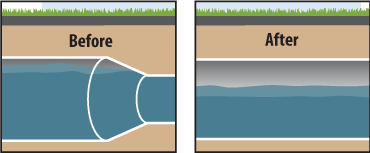About wastewater backup protection for South Park
Get information about King County’s work on wastewater backup protection in South Park.
Know your sewer
Side Sewer Pipe – your responsibility
Side sewer pipes are found underneath your driveway or alleyway. They carry wastewater to a sewer line under your local street. Property owners are responsible for installing, inspecting, maintaining, and repairing their side sewers.
Local Sewer Pipe – City’s responsibility in South Seattle
Local sewer pipes run underneath your city streets and arterial streets. In South Seattle, local sewer pipes are maintained by the City of Seattle. King County coordinates with the City to connect local sewer lines with King County’s regional wastewater system, but King County does not manage or maintain local sewers.
Note: a small number of homes in South Park are directly connected to King County’s pipes. If you have questions about your connection, please contact us.
County infrastructure – takes wastewater flows from the local sewer pipe to be treated
Learn more about the pipes and other infrastructure that collect and carry wastewater in King County to treatment plants here.
Unincorporated area of South Park
We have heard questions about sewer services in the unincorporated area near South Park known as “the sliver on the river.” Most of the residents in this unincorporated area have private septic systems. The few homes that are connected to the pipe system send wastewater from toilets and sinks to Seattle Public Utility’s pipes. The goal of the wastewater backup protection project is to address wastewater backups related to WTD’s system and does not address septic systems. For questions about septic services in that unincorporated area, please contact King County’s On-site Sewage System Program at 206-477-8050.
Timeline of work
-
2026 and beyond
The flow rerouting with stormwater and sewer separation project could begin the design phase as early as 2026. We will assemble a team of experts with experience in engineering, operations and maintenance, land use and permitting, environmental planning, construction, and community outreach to design and build the project in South Park.
WTD is hiring a contractor to install a flapgate on the 8th Ave Regulator Station. The flapgate will stop river water from entering the outfall pipe during high tides. We hope to start construction in Summer of 2026. This work was rescheduled from 2025.
![An illustrated image showing a large box labeled the 8th Ave Regulator Station. There is one pipe between the box and the Duwamish River and a solid line representing the Flapgate this is stopping water from coming in to the pipe.]](https://cdn.kingcounty.gov/-/media/king-county/depts/dnrp/waste-services/wastewater-treatment/capital-projects/south-park/images/13302_flapgate_370.png?rev=0e7208fde5a3426baaa76f33c7f76dee&hash=C2EEA633EC9E6CBBE2C1CEDDDC7D9ECB)
-
2024 - 2025
WTD continued the project planning phase for the future project. This includes confirming the option scope, performance measures and cost, requesting funding and continued coordination with Seattle Public Utilities.
Learn more: Project phases and how King County works with the public
-
2023 and 2024
We worked to identify which option or set of options will best help us meet our goal of protecting public health in the face of climate change. Separating stormwater and sewer separation and rerouting flows was selected as a future project.
-
Late 2022 – Early 2023
Worked with SPU to install backflow preventers such as grinder pumps to protect individual homes. Worked with SPU to develop a list of options that will reduce the potential for future residential wastewater backups caused by the impacts of climate change.
-
February 2022
Changed settings in the 8th Ave Regulator station that control when water flows through the outfall pipe into the river to reduce the potential for wastewater backups in homes and streets.

-
October 2021
Replaced section of pipe to help wastewater flow more easily.

What causes backups?
Wastewater backups can be caused by many things:

Pipes that carry both wastewater and stormwater fill up during storms more quickly than dedicated sewer pipes. WTD and SPU each manage large pipes in South Park that carry wastewater and stormwater from homes and businesses for treatment.

Heavier rains and rising sea level means more water filling our pipes. When pipes are too full, combined wastewater and stormwater is released to the river to protect property. High tides can prevent this release.

Plumbing fixtures on private property that are lower than City and County pipes are more likely to back up, especially if they do not have a backflow preventer installed.

Backflow preventers on private property that are not maintained or are installed improperly. Property owners need to maintain this equipment and keep pipes on private property clear.
 Translate
Translate